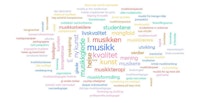In 1993, NMH was one of seven state-independent music education institutions, and by far the largest. The Music Academy was almost as large as the other six combined.
30 years later, NMH is the only remaining state-independent music education institution. In the report from Solvik (see link), there are several such comparisons regarding NMH's status today compared to 1993.
Other institutions and NMH's student numbers of the total in Norway
The development of music education institutions was noticeable in that the privately operated Barratt Due (BDM) was the only music education institution in addition to NMH in 1993. Today, performing/creative music education is offered at seven state institutions (UiT, NTNU, UiB, UiS, UiA, KHiO, and USN) as well as at five private institutions (BDM, HK, AH, NLA-Høyskolen, and LIMPI).
For the art field, the other state music education institutions have become university educations affiliated with the universities, and we have art colleges in Oslo and Bergen.
NMH student targets, including the Østlandet Conservatory of Music, accounted for 3.0% of all educational institutions 30 years ago. Today, NMH has 2.9% of the student population at all educational institutions in the country.
General features in the sector
Private institutions accounted for 8% of the total student population in Norway in 1993, while it had doubled to 16% in 2023. There were 127 state educational institutions and 17 private institutions in 1993. After the college reform in 1994 and the structure reform in 2015, there are now 21 state educational institutions and 15 private institutions. These and several other general developmental trends described in the report show that the institutional landscape has changed quite dramatically in Norway from a thirty-year perspective.





